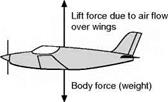The acceleration due to gravity
All objects near the surface of the earth have the force of gravity acting on them. If there is no opposing force, then they will start to move, to accelerate. The rate at which they accelerate is independent of their mass.
The force due to gravity (weight) F = m X g
but, from Newton’s second law, F = m X acceleration
By equating the two expressions above, we can see that the acceleration due to gravity will be numerically equal to the gravity constant g, and will be independent of the mass. Not surprisingly, many people confuse the two terms ‘gravity constant’ and ‘acceleration due to gravity’, and think that they are the same thing. The numerical value is the same, but they are different things. If a book rests on a table, then the weight is given by the product of the gravity
|
|
Fig 1.3 Aerodynamic and body forces constant and the mass, but it is not accelerating. If it falls off the table, it will then accelerate at a rate equal to the value of the gravity constant.
This brings us to the old problem of the feather and the lump of lead; which will fall fastest? Well, the answer is that in the vacuum of space, they would both fall at the same rate. In the atmosphere, however, the feather would be subjected to a much larger aerodynamic resistance force in relation to the accelerating gravity force (the weight), and therefore the feather would fall more slowly.
For all objects falling through the atmosphere, there is a speed at which the aerodynamic resistance is equal to the weight, so they will then cease to accelerate. This speed is called the terminal velocity and will depend on the shape, the density and the orientation of the object. A man will fall faster head first than if he can fall flat. Free-fall sky-divers use this latter effect to control their rate of descent in free fall.












